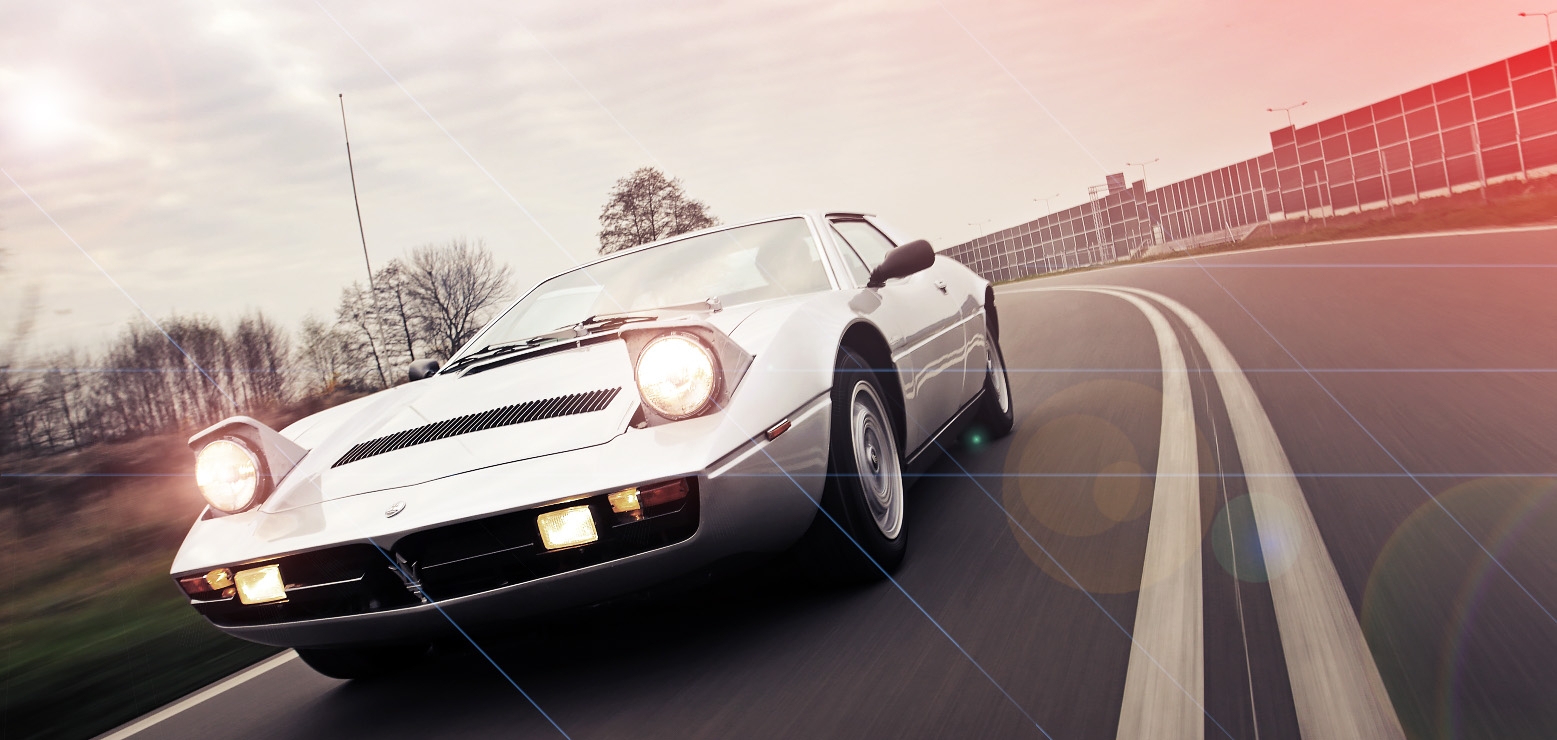
Maserati Merak SS smallest-capacity, mid-engined member of the Meserati family (as far as Britain is concerned; there is a 2-litre four-cylinder available abroad), with dimensionally the same Giugiaro-styled body as the 4.9 litre Bora. Dates from Geneva 1975 (Bora was launched at same motor show in 1971). Construction is steel chassisless, with double wishbone independent suspension on all corners, rack and pinion steering, and live-hydraulic powered brakes inherited in design from the previous association with Citroen.
With the pressures of a world recession, plus, to a smaller extent, the rising cost of petrol and the spread of dismal overall speed limits, it is a comment on the desire of man for safe speed that the supercar breed lives on. It is true that some makers of such cars have gone under, or drawn in their horns – but there s still a demand for fast, efficient, exciting-looking, better-than-average handling and roadholding sporting cars. The Merak SS – the 3-litre car strictly speaking sears the SS suffix to distinguish it from the 2-litre version labelled simply Merak in the few Continental markets where it is sold represents the bottom of the field as far as Maserati are concerned, even if it is not the cheapest (at £18,987 at the time of writing) or the lightest of its typo.
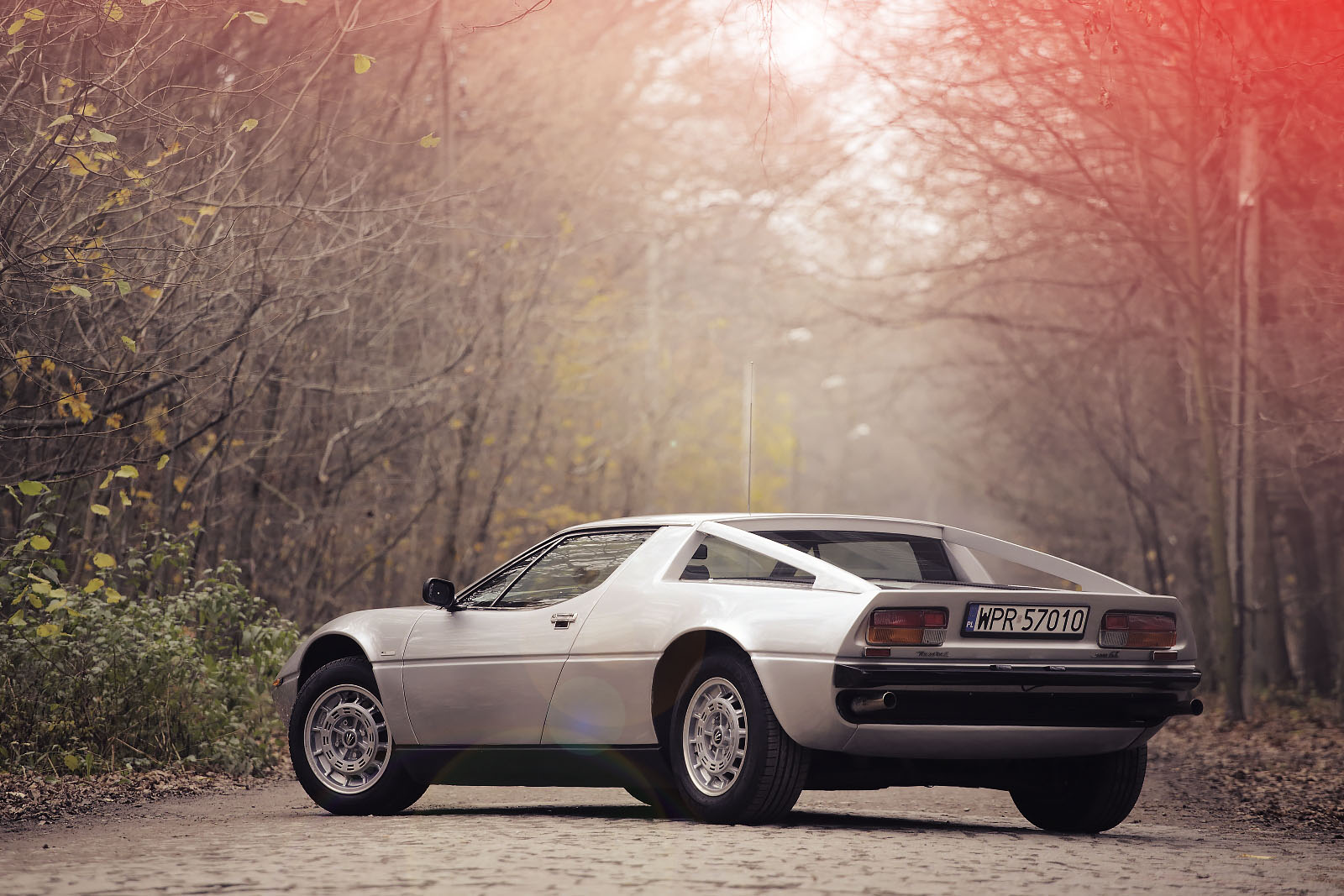
Mid-engined 2+2 cars (the Merak would perhaps be more fairly described as a 2+two halves, since its “seating” space behind is not nearly as generous as in say a Lotus Eclat) have one theoretical advantage over their front-engined, rear-drive and rear-engined rivals, and that is a more nearly ideal balance. For the benefit of the newcomer, putting the engine just ahead of the line joining the back wheel centres but behind the cockpit concentrates the heaviest single mass in the best possible place as far as dynamics are concerned. In acceleration, there is at least 15 per cent more of the car’s weight on the driven wheels than in a front-engine car, improving their grip and thereby their traction less wheelspin, more power converted usefully into forward motion. In braking, forward weight transfer occurs as in any car, but because of the rearward position of the centre of gravity, less weight is taken off the back wheels more balanced braking is possible. And in cornering, the reduced front-heaviness means less work for the front tyres, and therefore less understeer – better steering response and possibly slightly better grip. There can also be savings in weight compared with front-engined cars, thanks to getting rid of the propeller shaft.
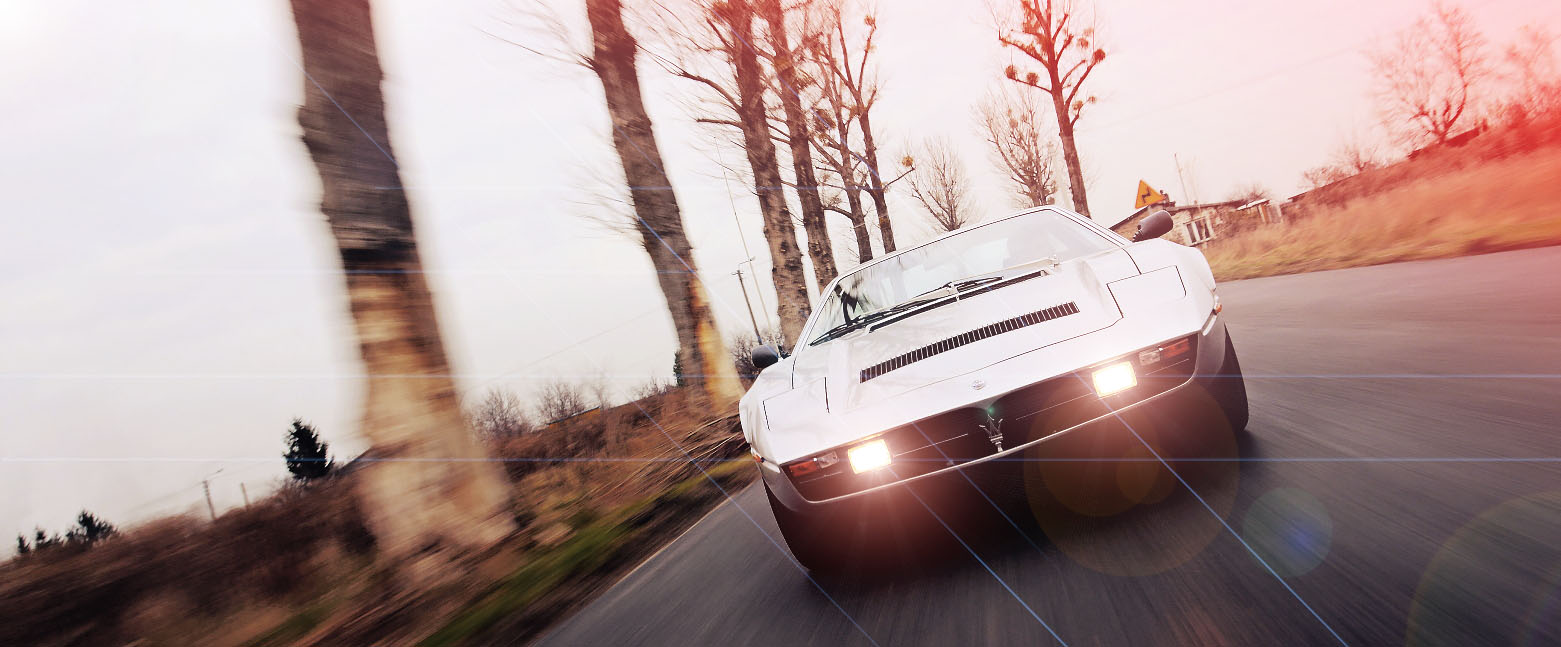
The disadvantages are equally well known. Biggest snag is probably convenience for both the occupant and the mechanic; less space for luggage and people awkward access for servicing. Experience so far suggests that insulating engine noise from the cabin is more difficult. In roadgoing cars which must comply with barrier crash tests, the position of the engine means that the cockpit space must be more strongly and therefore heavily walled, to avoid drive unit intrusion. It can be more difficult to provide good all-round visibility. Lengthy and probably many-jointed gearchange linkages make it more difficult to provide as good a change as in the much simpler case of the front-engine, rear-drive car. And the advantages in handling compared with a wellgeometry’d, tolerably balanced front-engine, rear-drive car are in practice arguable the classic design may perhaps lose a little in ultimate’s, but it can be distinctly easier to drive nearer and momentarily over its limit; it can be more forgiving.
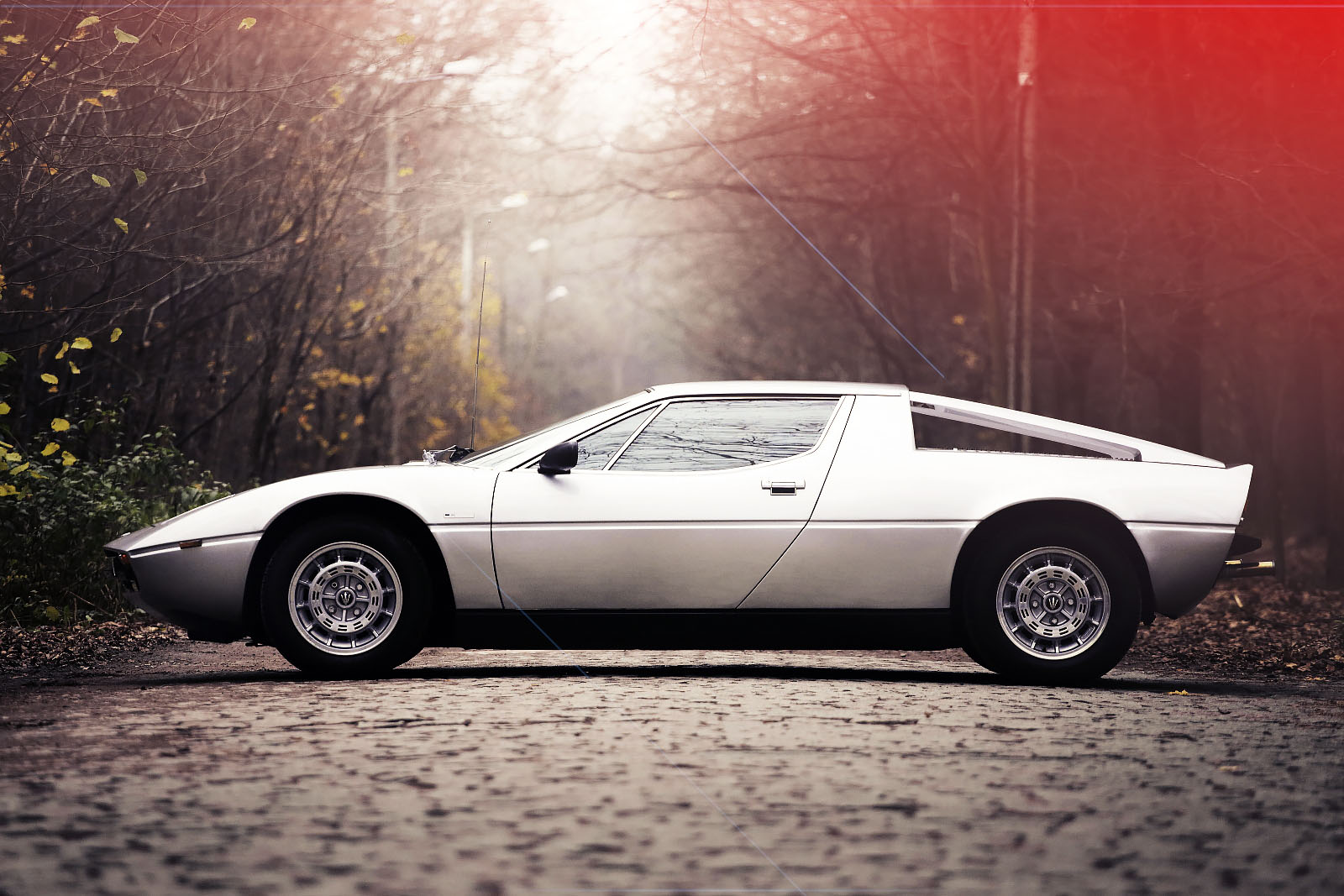
Performance
Deceptive – in the best ways
How does the Merak SS rate as a representative of the engine-behind-the-driver school? It certainly fulfils the first aim, of providing traction virtually as good as on a rear-engined car for best acceleration. Our brutal standing start test technique of dropping the clutch in with the revcounter needle pointing at 4,000 rprn produced enough wheelspin to keep the engine on song yet allowed an excellent getaway. This Maserati is no lightweight; at just over 27 cwt, it is nearly 7 per cent heavier thon the Ferrari 308 GTB and 14 per cent more than the Porsche 911 SC, it is therefore understandable that it docs not accelerate quite as quickly as those alternative 3-litre cars and in a curious way that is hard to explain, it does not feel spectacularly quick. Yet it is quick, very much so; 50 mph is reached in only 6.2 sec, 60 in 7.7, 80 in 13.3, the quarter mile in 15.8, 100 in 23.3 and 120 in just over half a minute.
| MAXIMUM SPEEDS AT TEST | |||
| Gear | mph | kph | rpm |
| Top (mean) | 143 | 230 | 6500 |
| (best) | 147 | 237 | 6650 |
| 4th | 112 | 179 | 6500 |
| 3rd | 79 | 128 | 6500 |
| 2nd | 54 | 87 | 6500 |
| 1st | 36 | 58 | 6500 |
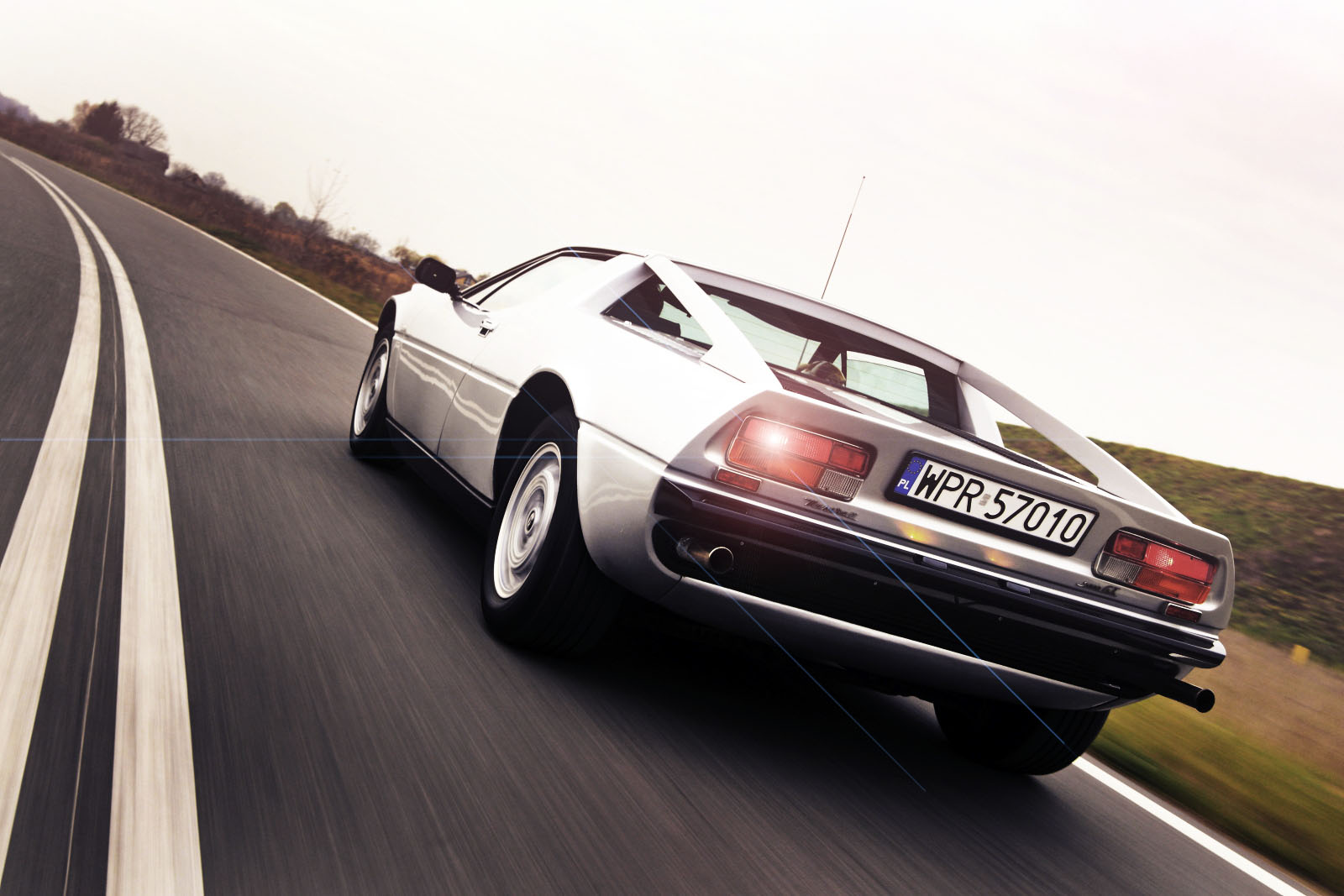
The car is geared for acceleration rather than top speed. Given a long enough straight and level road, the test Merak will run on to a mean maximum of 143 mph, which at 22.1 mph per 1,000 rpm in fifth corresponds to the engine’s red line speed of 6,500 rpm, 12 per cent over the claimed power peak. There is no rev-limiting engine cut-out to guard the red line, which is easy to exceed, such is the willingness of the power unit. Intermediate gear ratios are ideally chosen in practice, given the engine’s comparative flexibility. Changing up at the maximum power speed (5,800 rpm) achieves 32 mph in first, revs dropping to 3,850 in the 48 mph second, 3,900 in the 71 mph third, 4,150 in the 100 mph fourth and 4,500 rpm in top, where 5,800 rpm equates to 128 mph.
| Standing 1/4-mile: 15.8 sec, 89 mph | ||||||
| Standing km: 28.7 sec, 115 mph |
Compared with the Merak tested in Autocar of 4 January 1975, the current car is no quicker from the low to middle range, but gains appreciably at the top end, although it does not feel like a conspicuously top-end-y engine. Taking fourth gear 20 mph increments as an example, from 60 to 80 mph took 7.2 see on the 1975 car, and 7.4 sec now, but 90 to 110 was 10.7 sec and is now 8.8. In standing start times, the 1981 Merak overtakes the 1975 one from 60 mph onwards, its extra performance culminating in just over 5 sec trimmed off the 0-120 mph time.
The Merak gearchange is on the whole quite good, if a little ponderous, particularly on the change up from second to third, which during the racing-style lever movements of the test runs took conspicuously long. The test car is according to its metric distance recorder not old, having done the equivalent of 11,640 miles when we took it over, yet its synchromesh proved to be most unusually weak by any standards, grunting loudly if changes were only slightly hurried.
| True | Time | Speedo |
| mph | (sec) | mph |
| 30 | 3.3 | 30 |
| 40 | 4.5 | 40 |
| 50 | 6.2 | 50 |
| 60 | 7.7 | 60 |
| 70 | 10.7 | 71 |
| 80 | 13.3 | 81 |
| 90 | 16.3 | 91 |
| 100 | 20.3 | 101 |
| 110 | 25.3 | 111 |
| 120 | 31.9 | 122 |
| 130 | 39.1 | 133 |
| 140 | 42.2 | 143 |
The engine is, as said earlier, pleasantly flexible by the norms of the class, although not so entirely free of temperament as fuel-injected rivals such as the Porsche 911. Cold starts are fussy, noisy affairs, embarrassingly so in the 5.30 quiet of the road outside one tester’s house on the morning of the car’s departure for its autobahn maximum speed runs. The choke control is not effective, and so one had to use the accelerator pumps of the three downdraught Weber carburettors by pumping the throttle pedal two or three times to provide the necessary enrichment. Driveaway proved correspondingly uneasy, and the engine does not help by being comparatively slow to warm up.
| mph | Top | 4th | 3rd | 2nd |
| 10-30 | – | – | 6.1 | 2.1 |
| 20-30 | 11.8 | 7.8 | 5.5 | 2.2 |
| 30-50 | 11.1 | 7.6 | 5.3 | 2.9 |
| 40-60 | 10.8 | 7.6 | 4.9 | |
| 50-70 | 11.4 | 7.4 | 5.0 | |
| 60-80 | 11.5 | 7.4 | 5.6 | |
| 70-90 | 11.2 | 7.8 | 5.9 | |
| 80-100 | 12.1 | 8.5 | – | |
| 90-110 | 13.8 | 8.8 | – | |
| 100-120 | 15.1 | – |
A further, more alarming-seeming failing of the engine appears when one drives the car near its maximum for any length of time. The indication on the oil pressure gauge, which is sensibly placed straight in front of the driver, between speedometer and revcounter, falls away notably which is most disquieting. The phenomenon is one we have noticed before on these aluminium Maserati engines, and one suggestion is that at near to maximum engine speeds, perhaps main bearing clearances increase slightly due to bearing cap distortion under load. The behaviour of the pressure gauge needle tends to support this, since immediately the driver lifts off the accelerator pedal, cutting the power, the needle climbs sharply back to its normal position, almost as fast as a vacuum gauge needle swings back to vacuum with the same provocation. It should be stressed however that the fault only occurs if one runs the engine for more than a mile or so at above 6,000 rpm, and that (admittedly not very conspicuously, buried away in) the handbook specifically warns that “it is not advisable to drive with engine speed of over 6,000-6,500 rpm for long periods.” Also, unless the driver has a rare chance to drive the car to its maximum road speed, there is virtually no need to venture above 6,000 rpm, thanks to the wide power spread of the engine.
Economy
Good for its type
The Merak’s consumption can vary by a surprising range, wider than is usual in our experience. The worst we saw was 14.4 mpg during the flat-out performance measurement period. Our overall figure of nearly 18 mph is much more typical, whilst 20 mpg is not difficult to obtain if one restrains oneself. With the 18.7 gallon tank, one has a range of between 260 and 360 miles, once you have quickly learnt to ignore the absurdly early warning low level lamp, which comes on from half full onwards. The car’s tanks are well arranged with what must be a generous cross feed and breathing system, since it is relatively easy to brim without long waits for the last few drops to go in. There is only one filler, under a locking flap; the cap itself is a pleasingly made coarse-threaded type which is both positive to shut and easy to “start.” Oil consumption as before proved to be exceptionally high, at between 350 and 560 miles per pint. We also had to top up the hydraulic system reservoir during and after the performance testing, after oil blowing out of the reservoir breather made itself obvious by dropping on the right hand exhaust silencer. In normal driving, this problem disappeared.
| Overall mpg: | 17.9 (15.8 litres/100km) |
| Constant speed | |
| MPH | MPG |
| 30 | 31.0 |
| 40 | 30.6 |
| 50 | 29.0 |
| 60 | 27.6 |
| 70 | 26.1 |
| 80 | 24.3 |
| 90 | 22.2 |
| 100 | 20.5 |
| Manufacturers figures | 25.9 |
|
Drive-MY formula: |
|
|
Hard 16.1 mpg |
|
| Driving Average 19.7 mpg | |
| and conditons Gentle 23.3 mpg | |
| Grade of fuel: Premium, 4-star (98 / 100 RM) | |
| Fuel tank: 18.7 Imp galls (85 litres) | |
| Mileage recorder: 0.7 per cent short | |
| Official fuel consumption figures (ECE laboratory test conditions; (not necessarily related to Autocar figures) | |
| Urban cycle: 15.8 mpg | |
| Steady 56 mph 28.9 mpg | |
| Steady 75 mph: 26.4 mpg | |
| OIL CONSUMPTION | |
| (SAE 10W/50) 560 miles/pint | |
Noise
Mostly nice ones
Naturally, on all but coarsely concreted roads, it is the engine which is the dominant source of noise. Most fortunately, it achieves a compromise which in a sporting car is ideal, surprisingly quiet when cruising, so that one can just listen to the radio without having to turn up the volume too much, yet yielding to a delightful growl on acceleration, rising to a crying bellow which comes in from 5,000 rpm onwards.
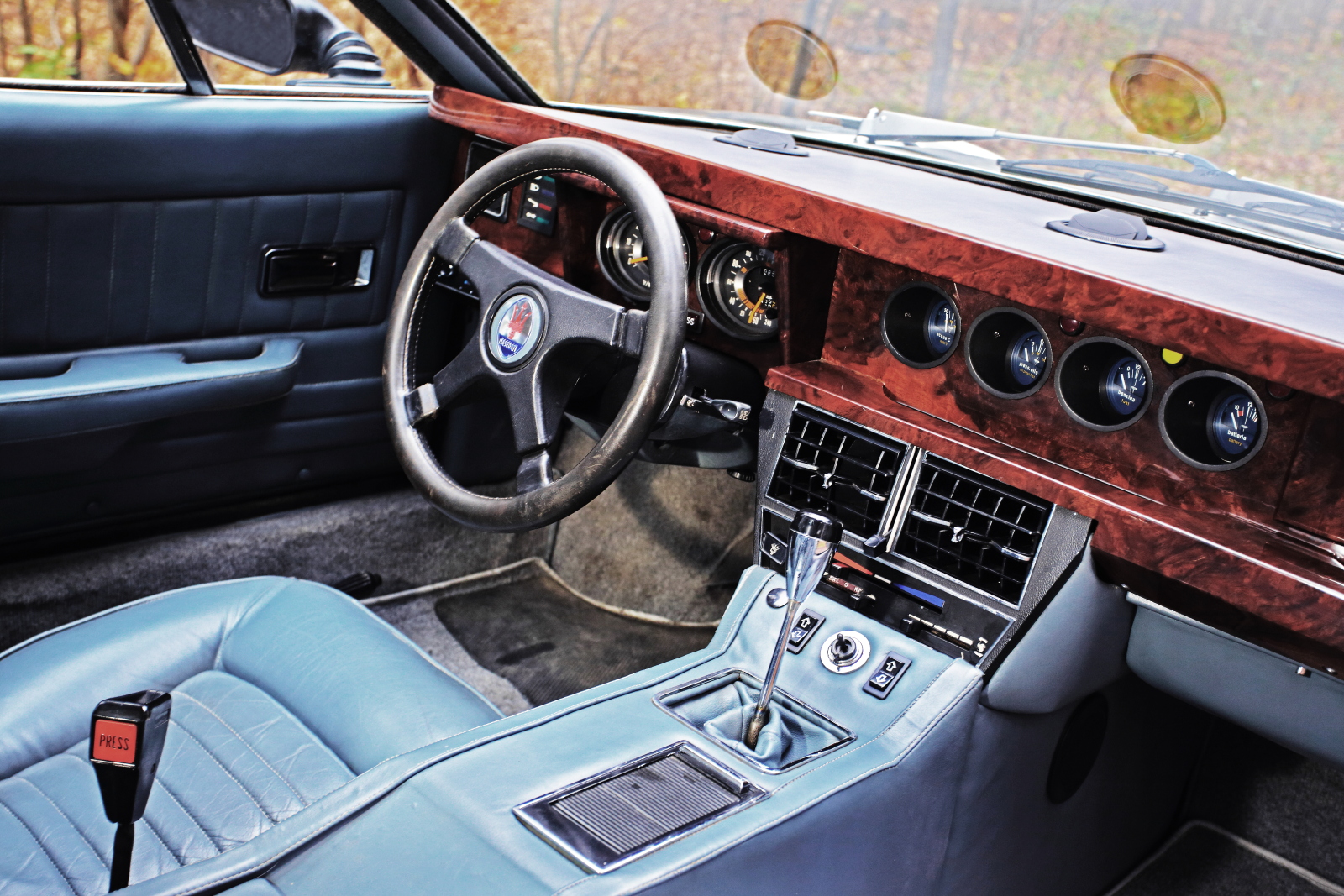
Alarmingly complicated at first the Merak dashboard takes some learning. Dials on the left re (from top left, clockwise) oil temperature, fuel water temperature, lock and battery volt gauges, with window switches on each side and low fuel lamp in a middle. Single air duct is under them, alongside slides for choke (left) and heater temperature control; rocker rich beneath is air conditioning control. Twiddle zero trip and air conditioning thermostat control are to the left of the speedometer. Oil pressure gauge lies centrally above brake pad wear and handbrake warning lamp. To right of rev counter are rocker switches (from left) for dashboard lights, rear window heater, heater fan and horn changeover. Knobs above them (from left) a for delay wipe period adjustment and ward flashers. Headlamps switch is at bottom right, beside radio. Stalks are right-hand drive, with pipers on the left and signalling head lamps on the right. Horn is worked ideally from central steering wheel crash pad.
Coarse surfaces are however bad producers of road noise, making travel on some sorts of motorway comparatively unpleasant because of the oppressive tone of the tyre roar, which produces a drumming resonance. Bump thump is correspondingly on the high side, if not as bad as on some competitors with more spectacularly low profile tyres than the 70 per cent XWX type of the Merak.
Wind noise is remarkably low. The ventilation system can make a whistle at around 70 mph if the centre outlet into the cabin is shut whilst the blower fan is left on its normally quiet first speed. The brake pedal produces an odd grunting nearly every time it is touched. The overall impression however is of a surprisingly civilized car which, except for the cold starts in the early hours mentioned, is not too noisy unless one is driving on a roughly surfaced road.
Road behaviour
Smooth cornering, sensitive stopping
The Merak steers like the best of the mid-engined Grand Tourers, combining straight stability comparable to good front-engined designs with pleasantly contradictory willingness to respond to a suddenly demanded swerve – which it will accomplish without any suggestion of unpleasant subsequent complications, like a fishtail series of counter-swerves.

It understeers just the right amount, so that it s stable in a straight line, yet its response is immediate – enough to make a clumsy driver mend his ways quickly by treating the car as delicately as it deserves. Cornered hard, the way the steering tells you what the front wheels are doing – the car has excelled feel, with just not too much kick-back over bumps – plus the small but sensible amount of roll, makes for easily achieved, very fast motoring on a winding road. The Merak will tighten its line just enough if one decelerates in a bend, but does no more than that. It is very well behaved in these respects. Steering weight is on the heavy side, but not toe much so except perhaps when parking.
| BRAKING | |||
| Fade (from 85 mph in neutral) | |||
| Pedal load for 0.5g stops in lb | |||
| start/end | start/end | ||
| 1 | 25-25 | 6 | 55-35 |
| 2 | 25-23 | 7 | 50-35 |
| 3 | 30-25 | 8 | 50-30 |
| 4 | 40-30 | 9 | 45-30 |
| 5 | 50-30 | 10 | 45-30 |
| Response (from 30 mph in neutral) | |||
| g | Distance | ||
| 10 lb | 0.16 | 188 ft | |
| 20 lb | 0.40 | 75 ft | |
| 30 lb | 0.55 | 55 ft | |
| 40 lb | 0.75 | 40 ft | |
| 60 lb | 0.95 | 31.7 ft | |
| Handbrake | 0.30 | 100 ft | |
| Max gradient | 1 in 3 | ||
| WEIGHT | |||
| Kerb, 27.3 cwt/3,062 lb/ 1.389 kg | |||
| (Distribution F/R, 40.3/59.7) | |||
| Test, 31.0 cwt/3,472 lb/1,575 kg | |||
| Max payload 660 lb/300 kg | |||
Aerodynamically, there seems to be little amiss. Its stability during the maximum speed runs gave perfect confidence. Side wind stability is, if not exceptional, certainly better than average. Ride is typical of such cars, rather knobbly over poor surfaces at low speed, improving to good as one goes faster. The faster-the-better technique is however limited by the Merak s ground clearance which is low enough for one to have to treat sleeping policemen with more than usual caution.
The one time wedding with Citroen has loft its mark on the Merak, long after the amicable divorce. At least, unlike the otherwise glorious Khamsin, the Merak does not suffer from that far from ideal feel-less Citroen powered-self-centring steering, but it does have the same company’s over-sensitive engine-driven power-hydraulic brakes. On the first acquaintance, it is exceptionally difficult to stop smoothly, even for an otherwise experienced driver, particularly from nigh speed, because such a relatively small, rather than simply light touch on the brake pedal is enough to provoke heavy braking. One docs get roughly used to this, but even then, the system is exactly the opposite of the ideal for a sporting car. Heel-and-toe changes, more than usually desirable on the test car given its poor synchromesh, are very difficult solely because of the brake pedal’s sensitivity. Braking on a bumpy road is hard too, as small movements of the right foot are noticed by the brakes.
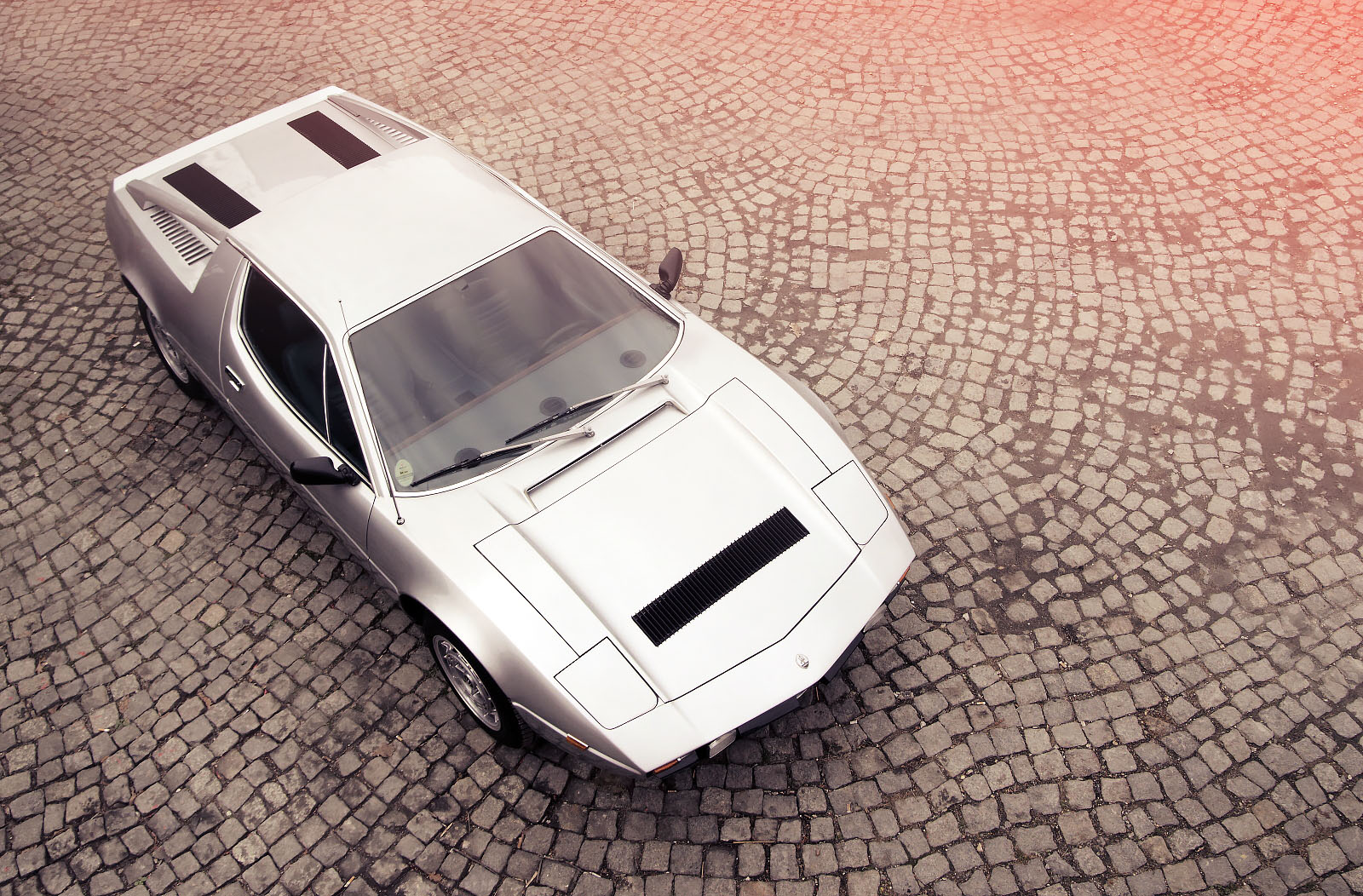
Much finer progression, certainly at the start of the brake response curve, would improve the system perfectly. The Maserati’s much shorter wheelbase, at 102in, 10in less than on the Citroen CX, makes matters worse, since pitch changes must be correspondingly greater under braking. In other respects the Merak’s brakes are excellent with good resistance to fade in spite of inboard rear discs. The right hand handbrake is however very poor, not even holding the car on the 1-in-6 test slope at MIRA.
Behind the wheel
Unusually comfortable
First impressions on opening the wide door and getting in are not favourable. The door, as on too many expensive Italian cars, has a check strap with no means of holding the door open when the inevitable lean of the car backwards or to the left tries to shoot before you are ready. There seems to be a confusion of many different sorts of switch, at least four of which are unlabelled arranged somewhat haphazardly in a way that looks old-fashioned today.
But, apart from that lack of a proper door check strap, these are the reactions of the newcomer. The owner soon learns what each switch and control does, and may indeed welcome their individuality as a way of identification. The car has unusually good headroom for its class. The driving position generally favours the traditional Latin, with rather less legroom for a 6ft or taller driver than he would like, but the usual simultaneous requirement for longer arms is avoided by the provision not only of steering column rake adjustment, but fore-and-aft steering wheel position movement as well. This is too rare in Continental cars, and is most welcome. The seat is comfortable on a long run, although when one exploits the car’s high cornering power, better sideways support would be a help.
Visibility, whilst not top class, is better than the admittedly poor average for this type of car. Ahead, the view is quite good, except in town in wet weather, when the wiper arcs could be of greater radius (if the pivot were moved too), so that more of the top of the windscreen were swept. To the side, the thickness of the central rollover protection pillars is a serious block of which account must be taken. Three-quarter-rear vision is appreciably easier than is usual in mid-engined cars, thanks to the gaps left under the unusual flying buttresses.
Heating is most disappointing, with the crudest of water valve temperature controls which has all the usual faults – get the temperature right after much experiment whilst cruising at high speed, then slow down and because the air flow through the heater matrix is slower, the air gets hotter; response is also very slow. The car takes over-long to warm up, which doesn’t help the already inadequate demisting arrangements. On a damp day, the side windows mist up easily, and there is no provision for demisting them. In the usual sledge- hammer-to-crack-a-nut fashion of Italian super cars in this respect, the makers try to offset some of the inadequacies of the heater by offering air conditioning as standard a small help.
There is a touch of temperament to the engine, besides its somewhat old-fashioned fussy starting. In town running, it tends to foul plugs slightly, which you notice on the first attempt to accelerate away when the road clears in front. The slight misfiring stops soon enough however, given a good blast of hard wide-open throttle.
Where oddment accommodation is concerned, mid-engined cars are expected to be loss good, but that is no excuse for the lack of anything in the cockpit other than the small lockable glove cubby at the extreme left of the dash. Door pockets could easily be provided, plus a central cubby; as it is, once the glove compartment is filled, there is no-where to put even a pencil or pen, let alone maps, unless you count the spaces into which they may be squeezed alongside the seats.
On the other hand, luggage room is unusually good for this type of car. The excellent boot in front is a simple, quite generous rectangular cube in shape, which will take up to two large-ish suitcases comfortably. In addition. the “seating” space behind the front seats – it is as usual really just a padded luggage space – offers both a useful extra bit of room for bags and so on, as well as avoiding that somewhat claustrophobic feeling felt by some in the strictly two-seater mid-engined car, with its rear firewall close to the back of one’s head.
One gets used to the whereabouts of controls, switches and the very comprehensive instrumentation. Instrument lighting and the multiplicity of sometimes unlabelled warning lamps leave something to be desired however. The instruments are too dimly lit to be read easily at night, whilst warning lamps for parking lamps, rear window heater, and fuel level – the last flashes at you far too soon to be taken seriously – are much too bright.
The Merak is certainly very well equipped. It has electric windows (quite quick ones), an oil temperature gauge, town and country horns both worked ideally from the big crash pad in the steering wheel, and a superb toolkit, in addition to all its other features. Its different-sized front and rear tyres create the usual spare tyre problem, which Maserati meet with a high pressure permanently inflated narrow section Michelin 105 R19X get-you-home spare, which lives in the back of the engine compartment, and on which you must not do more than 50 mph.
Engine access is not ideal, as far as the front end particularly is concerned, since it is somewhat buried. Important regular service items are however not difficult to find; the dipstick is reasonably within reach up at the front right of the engine, and the oil filler is more easily found at the back. The bonnet, released from a lever in the driver’s door jamb, is not self-propping.
There are basically four Maseratis available in 1980 Great Britain; two sizes of engine 2+2 Kyalami of which the 4.9-litre version is the only model available with automatic transmission at £29.900; the other Kyalami is the manual-only 4.1-litre at £25.998. Then comes the gloriously slender Bertone-styled 4.9-litre Khamsin, more of a 2+2 than the Kyalami, whose manual price it shares. The Merak is the baby some infant – at £18,987. Neither the Bora nor the big Quattroporte are imported today.
HOW THE MASERATI MERAK SS COMPARES
There isn’t a host of mid-engined 2+2 cars available in the 3-litre class today, and even if one widens the field slightly by including the honest two-seaters (as opposed to the dishonest 2+2), the choice is still limited. Widen things further, as the potential buyer is very likely to anyway, and besides the cars we have chosen, there are some others of near the same price bracket. We haven’t tested De Tomaso’s Pantera GTS (£17.940), or the other Ferrari, the Mondial 8 (£24,488). Jaguar’s XJS is an obvious contender of tremendous attraction in a clearly different class (similar to the BMW coupe’s) and very tempting for the man who can afford the extra petrol bill and can forgive Jaguar for hobbling the car with automatic transmission only. It is of course comfortably faster (151 mph. 6.6 sec to 60 and 14.3 mpg overall obtainable for £19.763). The Lotus Esprit Turbo must certainly be reckoned with at £20,900; untested by us to date, but not untried, it is an incredibly impressive machine in handling and performance.
ON THE ROAD
Pleasing as it is in many other ways, and comparatively much more civilised and easy to live with than the others, BMW’s 635 CSi E24 stumbles somewhat in this category with the wayward behaviour of its semi-trailing arm, camber-changing back suspension. The Porsche 911 is as ever an even naughtier handler, flattering the driver who keeps his foot down that it will take him round any corner at almost any speed, until he has to lift off unexpectedly, when the consequent rear-end breakaway is very hard to hold. The rear-engined Porsche also disappoints severely in sidewind stability, making it a hard car to master, if an immensely satisfying one in its fantastic combination of electric acceleration and traction. The other Porsche, the big 928 front-engined one, is much better behaved, although it can let go at the back somewhat surprisingly in view of its normally suave manners. It is hard to say which of the three remaining cars, all mid-engined. handles best; the Ferrari, Lotus and Maserati are all very pleasing in their grip and behaviour, and there is little to choose between them until it comes to braking, where the Maserati’s over-sensitive Citroen system makes it unnecessarily difficult to brake hard.
To be fair here, one must divide our contenders in to the front- and back- engine, since the former have a clear and easy advantage, thanks partly to their layout and of course to the fact that in these particular cases they are appreciable bigger cars.
Of the cars with engines behind the driver, the Porsche 911 is probably the most civilised. It is true that its air-cooled engine limits its heater suitability, in spite of sophisticated- seeming controls. But where its ability to fit a wide range of driver sizes is concerned, plus it’s quite generous rear seating, easy view out on all sides and trim proportions, it is virtually unrivalled in this class a delightfully j easy and practical sports coupe to live with. The Esprit is of course a pure two seater, comfortable enough but not generous in accommodation for things besides two people. The same applies to the Ferrari, leaving the more expensive Mondial as the only small 2+2 rival from this distinguished stable. The Merak comes out better than usual in this respect, as far as driver comfort is concerned, with its very welcome telescopic as well as rake-adjustable steering column.
VERDICT
In this case, final choice is very much a matter of horses for courses. If true civilisation and convenience are as important as anything else, then the big Porsche comes out on top. If you I are prepared to drive within the handling limitations of the BMW, then the M635 CSi E24 is a lovely and delightful car, certainly very easy to make a companion for life. For drivers who need not or do not want to compromise so much, the 911 SC is less expensive, very efficient, enormously satisfying to drive in a straight line when there isn’t much side wind; its acceleration is truly extraordinary, bringing a new meaning to the word as far as road- going cars are concerned. It is also surprisingly civilised to live with. For the man who wants the best in roadholding and performance, plus in many opinions good looks, it cannot help being the Ferrari, closely attended in handling if not performance by the Lotus. The Merak’s fortes are its quite good refinement, excellent handling it those brakes excepted) and comparative roominess.
PRODUCED BY: Officine Atfieri Meserati SpA, Viate Ciro Monoiti 322, 41100 Modena, Italy.
SOLD IN THE UK BY: Modena Concessionaries, International Motors, Ryder Street, West Bromwich, West Midlands.
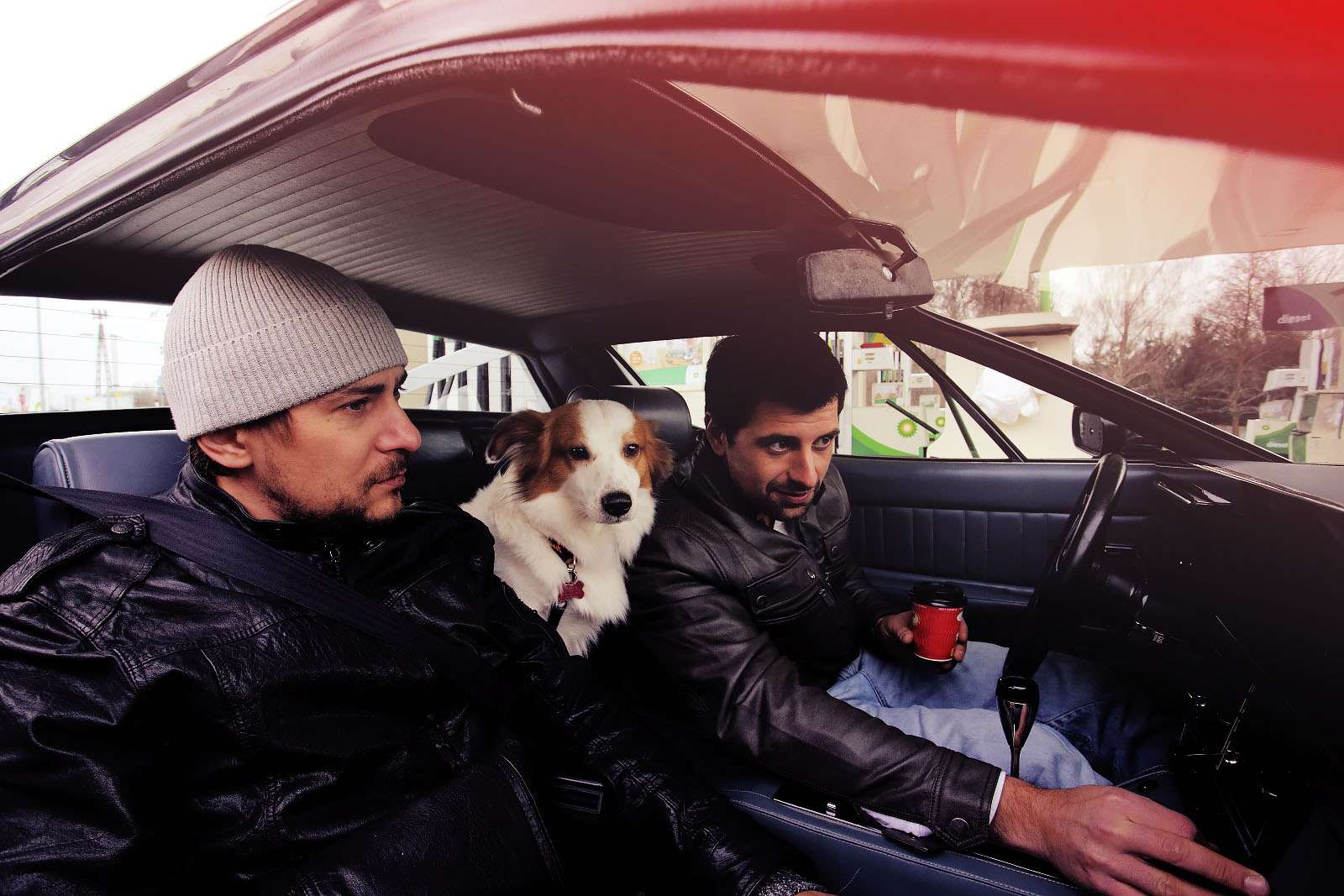
Luggage compartment in front is unusually generous and sensibly shaped for this type of a car. Rear “seat” space is better used as padded luggage space. Seats are comfortable, but could do with better sideways location to match the car’s cornering power.
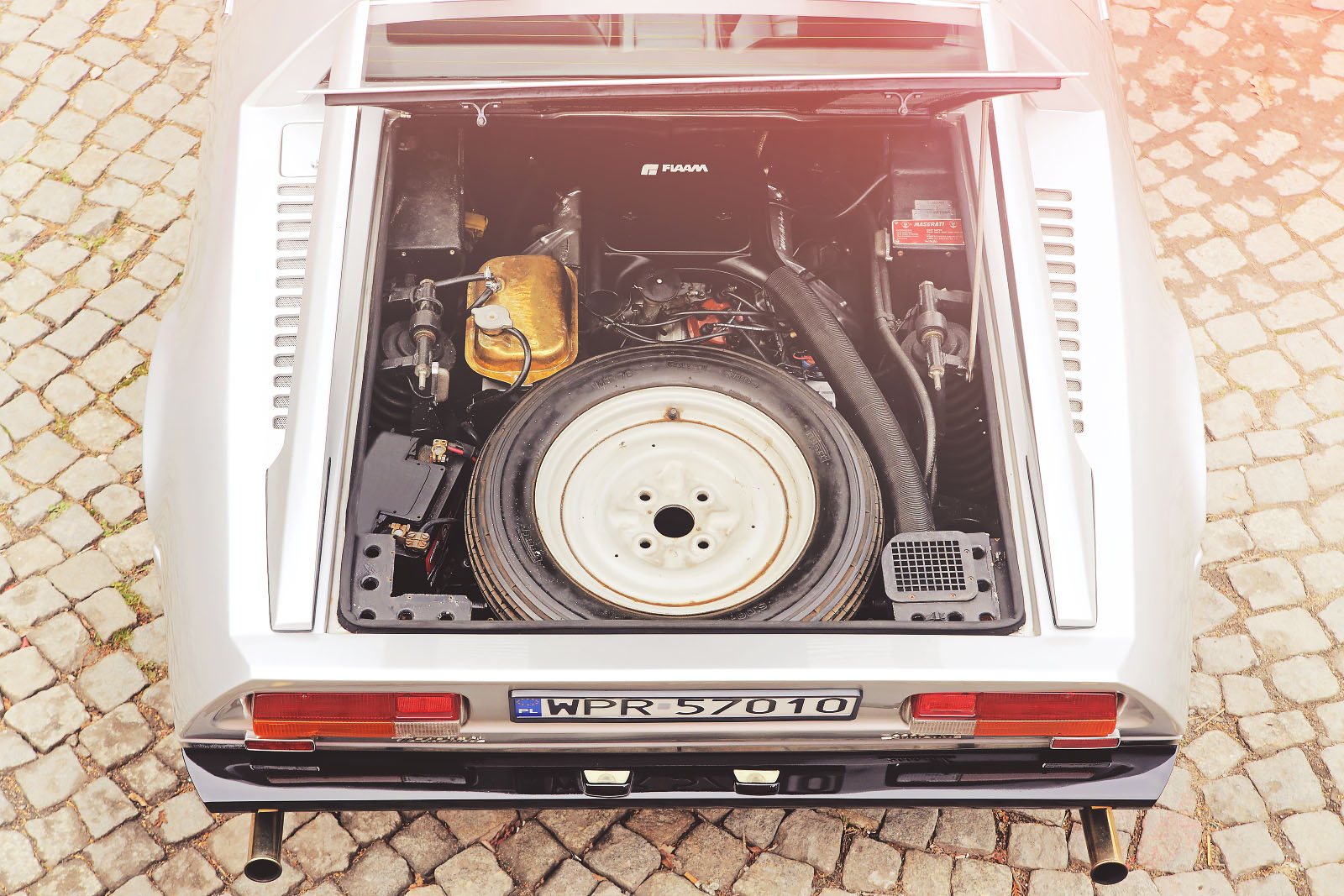
Engine bay looks cramped even with spare wheel removed, thanks to thrust-forward position of the power unit. Items needing regular attention are, however, not difficult to find although the dipstick (hidden are on right hand side of engine) is gather a stretch to each. Bonnet lid is not self propping. Above: This drive puts three major accessories neatly at the bock of the engine compartment, all driven by toothed belts alternator (nearest camera), hydraulic pump and air conditioning compressor. Below: Road wheels are different size front and rear; spare is a high-pressure narrow section Michelin, good for up to 50 mph only.
| Car | 1981 Maserati Merak SS |
| Made in | Italy |
| Number built | 1972-1983 / 1830 made |
| Car type | Mid engine, rear wheels drive |
| ENGINE | |
| Type | Maserati V6 |
| Head/block | All alloy head / All alloy block |
| Cylinders | V6 |
| Main bearings | 5 |
| Cooling | Water |
| Fan | Electric |
| Bore, mm (in.) | 91.6 (3.60) |
| Stroke, mm (in.) | 75.0 (2.95) |
| Capacity, cc (in.) | 2.965.5 (181.04) |
| Valve gear | DOHC |
| Camshaft drive | Chain |
| Compression ratio | 8.75-to-1 |
| Ignition | Breakerless Marelli |
| Fuel injection | 2-twin Weber 42 DCNF31 and one Weber 42 DCNF32 |
| Max power | 208 bhp (PS-DIN) 157 (kW ISO ) at 5.800 rpm |
| Max torque | 188lb ft (255 Nm) at 4.500 rpm |
| TRANSMISSION | |
| Type | Citroen 5-speed manual |
| Clutch | Diaphragm, 9.5in dia |
| Gear Ratio | mph/1000rpm |
| Top 0.73 | 22.10 |
| 4th 0.94 | 17.60 |
| 3rd 1.32 | 12.22 |
| 2nd 1.94 | 8.32 |
| 1st 2.92 | 5.63 |
| Final drive gear / Ratio | Hypoid bevel / 4.85 to 1 |
| SUSPENSION | |
| Front location | Double wishbone |
| springs | Coil |
| dampers | Telescopic |
| anti-roll bar | Yes |
| Rear location | Double wishbone |
| springs | Coil |
| dampers | Telescopic |
| anti-roll bar | Yes |
| STEERING | |
| Type | Rack and pinion |
| Power assistance | No |
| Wheel diameter | 14 in. |
| Turns lock to lock | 3 ½ |
| BRAKES | |
| Circuits | Two, split front/ front and rear |
| Front | 11.02 (282.9mm) in. dia. ventilated disc |
| Rear | 11.81 (283.9 mm) in. dia. ventilated disc |
| Servo | High pressure hudraulic system of Citroen |
| Handbrake | Side lever, rear disc |
| WHEELS | |
| Type | Aluminium alloy Campagnolo |
| Rim Width | 7 1/2 x 15 |
| Tyres make | Michelin |
| type | XVX steel radial tubeless |
| size | 70 VR15in / 205 front / 215 rear |
| pressure | F33. R36 psi |
| EQUIPMENT | |
| Battery | 12V 72 Ah |
| Alternator | 70A |
| Headlamps | 12V 55/60W |
| Reversing lamp | Standard |
| Hazard warning | Standard |
| Electric fuses | 17 |
| Screen wipers | Two-speed plus intermittent |
| Screen washer | Electric |
| Interior heater | Water valve |
| Air conditioning | Extra |
| Interior trim | Leather or cloth seats, pvc head-lining |
| Floor covering | Carpet |
| Jack | Screw pillar |
| Jacking points | Two each side, under sills |
| Windscreen | Laminated, tinted |
| Underbody | Paint system. |
| protection | bitumastic. pvc |





